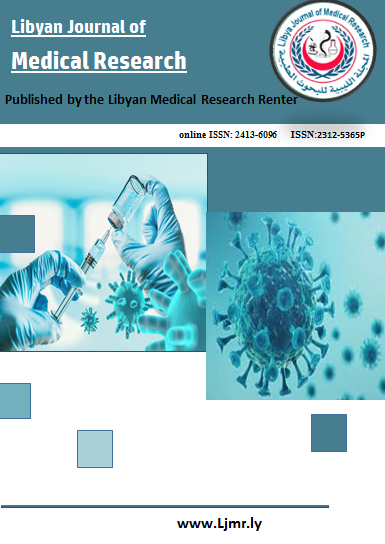Comparative Study Between Aqueous Drops and Gel Drops in Treating Dry Eye
DOI:
https://doi.org/10.54361/LJMR.19.1.16Keywords:
Dry eye, aqueous drops, gel drops, treatment assessment, eye comfort, eye hydration, quality of life, clinical outcomes, health improvementAbstract
Pauper: It is a comparison between the effectiveness and effects of aqueous drops and gel drops in treating dry eye, with a focus on evaluating their effectiveness and side effects.
Methods: A study on dry eye was conducted using aqueous drops and gel drops based on the opinions of doctors and patients, with an analysis of previous studies comparing them in terms of ease of use, duration of effect, and side effects.
Resultes: The results showed that aqueous drops are effective but their effect is not long-lasting and may cause some burning and redness, while gel drops are more effective in keeping the eye moist for a longer period. Based on this, it was concluded that gel drops provide a better treatment option for dry eye patients.
Downloads
References
Markita, M. (PhD). "Dry Eye Disease: A Review." Masaryk University, Brno, Czech Republic.
Abu Hussein, H. "Dry Eye: Causes and Treatments." Journal of Medicine and Life
Estrela, M. "Sjögren’s Syndrome and the Application of Artificial Tears." Clinical Pharmacy Specialist.
Salem, S., Soumana, S., & Sanghta, S. "Comparison of Efficacy Between Hyaluronate Eye Drops and Carboxy methyl cellulose Eye Drops in the Treatment of Mild Dry Eye."
Investigative Ophthalmology & Visual Science. "Assessment of Vision-Related Quality of Life in Dry Eye Patient
Ng, B.C., & Hutton, H.M. "Sodium Hyaluronate in the Management of Dry Eye Syndrome."
Abeer, R., Rahaf, F., Fares, et al. "Eye Health." Saudi Ophthalmology Association.
. Simoter, P., Carlisle, C., & Fig, J.J. "Comparison of Newly Approved Lipid-Based Eye Drops and Aqueous Drops for Dry Eye: A Randomized Trial."
Brown, A. "Dry Eye Disease." Novid Ophthalmology Lab, University of Oxford.
Song, J.K., Park, H.Y., et al. "Efficacy of Carboxymethylcellulose and Sodium Hyaluronate in the Treatment of Dry Eye Disease."
Downloads
Published
Issue
Section
License
Copyright (c) 2025 Naziha Al-Haj Yahya, Youssef Mohammed Salah (Author)

This work is licensed under a Creative Commons Attribution-NonCommercial-NoDerivatives 4.0 International License.
Open Access Policy
Libyan journal of medical Research (LJMR).is an open journal, therefore there are no fees required for downloading any publication from the journal website by authors, readers, and institution.
The journal applies the license of CC BY (a Creative Commons Attribution 4.0 International license). This license allows authors to keep ownership f the copyright of their papers. But this license permits any user to download , print out, extract, reuse, archive, and distribute the article, so long as appropriate credit is given to the authors and the source of the work.
The license ensures that the article will be available as widely as possible and that the article can be included in any scientific archive.
Editorial Policy
The publication of an article in a peer reviewed journal is an essential model for Libyan journal of medical Research (LJMR). It is necessary to agree upon standards of expected ethical behavior for all parties involved in the act of publishing: the author, the journal editorial, the peer reviewer and the publisher.
Any manuscript or substantial parts of it, submitted to the journal must not be under consideration by any other journal. In general, the manuscript should not have already been published in any journal or other citable form, although it may have been deposited on a preprint server. Authors are required to ensure that no material submitted as part of a manuscript infringes existing copyrights, or the rights of a third party.
Authorship Policy
The manuscript authorship should be limited to those who have made a significant contribution and intellectual input to the research submitted to the journal, including design, performance, interpretation of the reported study, and writing the manuscript. All those who have made significant contributions should be listed as co-authors.
Others who have participated in certain substantive aspects of the manuscript but without intellectual input should only be recognized in the acknowledgements section of the manuscript. Also, one of the authors should be selected as the corresponding author to communicate with the journal and approve the final version of the manuscript for publication in the LJMR.
Peer-review Policy
- All the manuscripts submitted to LJMR will be subjected to the double-blinded peer-review process;
- The manuscript will be reviewed by two suitable experts in the respective subject area.
- Reports of all the reviewers will be considered while deciding on acceptance/revision or rejection of a manuscript.
- Editor-In-Chief will make the final decision, based on the reviewer’s comments.
- Editor-In-Chief can ask one or more advisory board members for their suggestions upon a manuscript, before making the final decision.
- Associate editor and review editors provide administrative support to maintain the integrity of the peer-review process.
- In case, authors challenge the editor’s negative decision with suitable arguments, the manuscript can be sent to one more reviewer and the final decision will be made based upon his recommendations.














